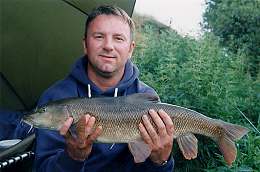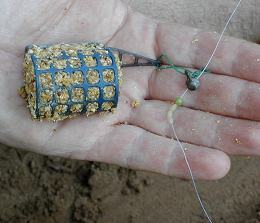 Despite the west country nickname, Wurzel, Paul Hiom was born on the banks of the River Thames at Chiswick in West London, but now resides in Swindon, Wiltshire.
Despite the west country nickname, Wurzel, Paul Hiom was born on the banks of the River Thames at Chiswick in West London, but now resides in Swindon, Wiltshire.
The fact that the Fullers Brewery was no more than quaffing distance from his birth place has nothing to do with the latter affliction, however, the lead-choked atmosphere of the city has been blamed for the occasional bouts of madness. Paul considers himself a half-serious specialist who has dabbled in most things fishing-related with varying degrees of success, but is in the main a pike and barbel man with personal bests of 24lb 8oz and 11lb 10oz respectively.
KISS! Or, Keep It Simple Stupid! Which is one way to remind yourself that when it comes to fishing, nine times out of ten it is the simplicity of a method or rig that makes it successful.
Most if not all of the rigs I use for barbel are based on a simple link-leger which has been very slightly modified to enhance its use and presentation. Barbel are not usually difficult fish to catch once located and, therefore, the fancy rigs used, for example, in carp fishing can be an unnecessary encumbrance. The hair rig is about as technical or complex as I get and I include and recommend the use of the hair in some, but not all, circumstances.
It has to be remembered that barbel have an under slung mouth, they do not suck up their food from a short distance like spooky carp. However, on more pressured venues, barbel are known to move backwards very slowly with a bait in their mouths, checking for resistance. More often than not a barbel will move up to a bait, maneuver its top lip over it, close its mouth, and shoot off downstream, resulting in the classic pull, this is the time to strike home the hook. When using a hair rig you rarely get any prior indication of a bite except the occasional drop back as the fish pulls against the lead, as it moves upstream with the bait. This results in the rod top straightening, followed by the fish charging off as it hooks itself. 
My fishing is usually based on one or two approaches. The first being a mobile approach which will see me baiting up several swims which I fish and re-bait in rotation. The second being a fairly static approach which may see me fishing a swim with up to two rods, fishing different baits and methods. Nothing new in that, these are fairly standard approaches that work well, depending upon the venue.
My tackle for the first approach is usually a standard link-leger on a Sufix Herculine braided mainline, to which I attach a l0lb Berkley sensi-thin mono hooklength of around 12 to 14 inches. If circumstances require it, I may present a bait on a Kryston Silkworm braided hooklength. I will fish a meat bait directly on a Eustace Penetrator 1 or Hutchinson Vice Rig Hook in size 4 or 2, touch-legering to feel for bites through forefinger and rod butt.
A bite, no matter how sensitive, will be picked up through the braid and I am confident that due to the lack of stretch in the braided mainline, I will pull the hook quickly through the meat and into the barbel’s top or bottom lip. I will also use a breakaway or semi-fixed running lead set up (courtesy of Roger Miller) as I have found that tangles are reduced, especially with braided hooklengths, and I can safely pull out of river bed snags enabling me to retrieve my hooklength, etc. The link clip is removed from the leger bead and replaced with a powergum link to which I fix various sized leads depending upon method and flow of river. I will fix a John Roberts camo-coloured leger bead above a standard green bead which sits on the swivel above the hooklength.
The rod will not be held, but rather placed in a tall rod rest. As I am not touch-legering I will need the benefit of knowing that the rig will hook the fish and this is where the hair-rig comes into play. I often adopt an unconventional approach in that this rod may at times be fished without any pre-baiting of a swim if barbel are around in reasonable numbers, although more often than not, and especially on smaller rivers, or when fishing close to the margin on larger rivers, a bait-dropper will be used to introduce hemp, other particles ,or pellets, into a confined area. On larger rivers I may use a PVA bag to get freebies around my hookbait or feed an area prior to fishing with a large blockend or cage feeder, depending on the bait being introduced. 
The second rod, if used, will be a feeder or quivertip rod, again placed in a tall rod rest. I use a large maggot/hemp swim feeder. This rod will usually be fished with 8Ib mono such as Bass Pro Excel straight through to a Kamasan Specimen hook in size 14 or 12. The rig I use is based on the old leger-stop principle, only I replace the leger stop with three small drennan float stops. A small bead and John Roberts leger bead sits above. The float stops overcome the damage that can be caused by plastic leger stops or by tightening powergum onto the mainline. Three float stops are required to take the force of casting, any less and your swim feeder will slip down to your hook, rendering the presentation of your bait useless. I have found that I can comfortably cast a 2 1/2 oz feeder using this rig, although further float stops may be required for heavier feeders/leads.
I could go on about all sorts of variations on the above themes. However, for most fishing situations, I will utilise the above simple but effective set-ups and they should cover most of the barbel fishing you wish to try. These are rigs for fairly standard approaches. As you delve deeper into the realms of barbel fishing you may want to play around with your own ideas, but I would re-iterate that it is important to keep things simple.










